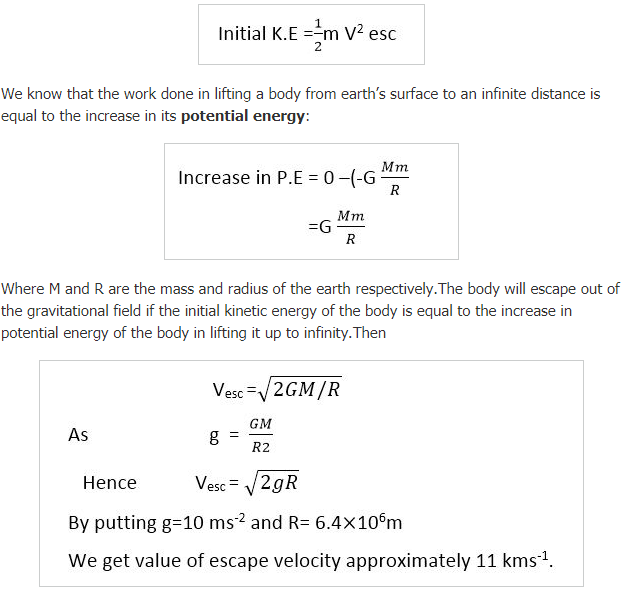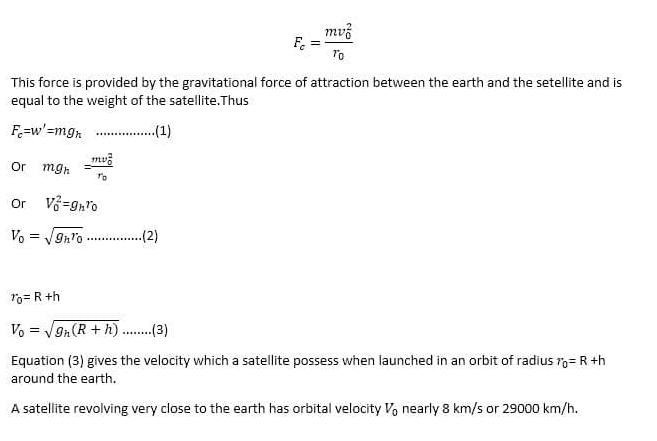Class 11 Exam > Class 11 Questions > What is difference between escape velocity an...
Start Learning for Free
What is difference between escape velocity and orbital velocity
Most Upvoted Answer
What is difference between escape velocity and orbital velocity
Escape velocity
“The velocity required by a body to escape from the earth’s gravitational field.”It is our daily life experience that an object projected upward comes back to the ground after rising to a certain height. This is due to the force of gravity acting downward. With increased initial velocity, the object rises to the greater height before coming back. If we go on increasing the initial velocity of the object,a stage comes when it will not return to the ground. It will escape out of the influence of gravity. The initial velocity of an object with which it goes out of the earth’s gravitational field is known as E.V.
Escape velocity formula
The E.V corresponds to the initial kinetic energy gained by the body,which carries it to an infinite distance from the surface of earth.

Orbital velocity
When the object in the earths orbit ,its motion is known as orbital motion.The velocity by which the object moves in the earth’s orbit is called orbital velocity.It remains constant in the gravitational field.
The earth and some other planets revolve around the sun in closely circular paths.The artificial satellites launched by men also adopt nearly circular course around the earth.This type of motion is called orbital motion.Formula of this velocity is given as:
Consider a satellite going round the earth in circular path.The mass of the satellite is m and v� is the orbital speed.The mass of the Earth is M and r� represents the radius of orbit.A centripetal force is required to hold satellite in orbit which is given as:

Community Answer
What is difference between escape velocity and orbital velocity
The orbital velocity is the velocity an object must maintain in order to be on a certain orbit. For an object going on an orbit with radius r, the orbital velocity is given by the square root of (F r / m) where F is the net inward force and m is the mass of the orbital object. The inward force in a mass system is GMm/r2. By substituting this, we get the orbital velocity as the square root of (GM/r). This also can be proved using mechanical energy conservation of a conservative field.As we know from the gravitational field theory, an object having a mass always attracts any other object which is placed in a finite distance from the object. As the distance increases the force between the two objects lowers with the inverse square of the distance. At infinity, the force between the two objects is zero. The potential of a point around a mass is defined as the work that has to be done to bring an object of unit mass from infinity to the given point.
The orbital velocity is the velocity an object must maintain in order to be on a certain orbit. For an object going on an orbit with radius r, the orbital velocity is given by the square root of (F r / m) where F is the net inward force and m is the mass of the orbital object. The inward force in a mass system is GMm/r2. By substituting this, we get the orbital velocity as the square root of (GM/r). This also can be proved using mechanical energy conservation of a conservative field.
As we know from the gravitational field theory, an object having a mass always attracts any other object which is placed in a finite distance from the object. As the distance increases the force between the two objects lowers with the inverse square of the distance. At infinity, the force between the two objects is zero. The potential of a point around a mass is defined as the work that has to be done to bring an object of unit mass from infinity to the given point.
The orbital velocity is the velocity an object must maintain in order to be on a certain orbit. For an object going on an orbit with radius r, the orbital velocity is given by the square root of (F r / m) where F is the net inward force and m is the mass of the orbital object. The inward force in a mass system is GMm/r2. By substituting this, we get the orbital velocity as the square root of (GM/r). This also can be proved using mechanical energy conservation of a conservative field.
As we know from the gravitational field theory, an object having a mass always attracts any other object which is placed in a finite distance from the object. As the distance increases the force between the two objects lowers with the inverse square of the distance. At infinity, the force between the two objects is zero. The potential of a point around a mass is defined as the work that has to be done to bring an object of unit mass from infinity to the given point.

|
Explore Courses for Class 11 exam
|

|
Question Description
What is difference between escape velocity and orbital velocity for Class 11 2025 is part of Class 11 preparation. The Question and answers have been prepared according to the Class 11 exam syllabus. Information about What is difference between escape velocity and orbital velocity covers all topics & solutions for Class 11 2025 Exam. Find important definitions, questions, meanings, examples, exercises and tests below for What is difference between escape velocity and orbital velocity.
What is difference between escape velocity and orbital velocity for Class 11 2025 is part of Class 11 preparation. The Question and answers have been prepared according to the Class 11 exam syllabus. Information about What is difference between escape velocity and orbital velocity covers all topics & solutions for Class 11 2025 Exam. Find important definitions, questions, meanings, examples, exercises and tests below for What is difference between escape velocity and orbital velocity.
Solutions for What is difference between escape velocity and orbital velocity in English & in Hindi are available as part of our courses for Class 11.
Download more important topics, notes, lectures and mock test series for Class 11 Exam by signing up for free.
Here you can find the meaning of What is difference between escape velocity and orbital velocity defined & explained in the simplest way possible. Besides giving the explanation of
What is difference between escape velocity and orbital velocity, a detailed solution for What is difference between escape velocity and orbital velocity has been provided alongside types of What is difference between escape velocity and orbital velocity theory, EduRev gives you an
ample number of questions to practice What is difference between escape velocity and orbital velocity tests, examples and also practice Class 11 tests.

|
Explore Courses for Class 11 exam
|

|
Signup to solve all Doubts
Signup to see your scores go up within 7 days! Learn & Practice with 1000+ FREE Notes, Videos & Tests.





















